CBE Starter Pack 6: Equity Strategies Drive Culture, Structures, and Pedagogy
CompetencyWorks Blog
When educators begin to explore competency-based education (CBE), the CompetencyWorks Initiative is a key place to find information and ideas. It can be overwhelming to know where to start. This post about equity strategies is the sixth of a series of “CBE Starter Packs” focused on each of the seven elements of the Aurora Institute’s 2019 CBE Definition.
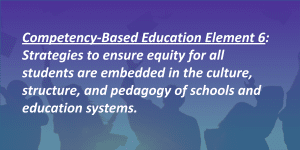
In our definition of competency-based education, designing for equity in access and outcomes drives our purpose. Equity is central to ensuring quality education for all learners, regardless of their backgrounds and needs. CBE is an equity-based strategy. In a fully developed CBE system, every child gets their needs met to reach their full academic and social potential to thrive in a changing world. The National Equity Project builds on this definition of educational equity by naming that working toward equity in schools involves:
- Ensuring equally high outcomes for all participants in our educational system;
- Removing the predictability of success or failures that currently correlates with any social or cultural factor;
- Interrupting inequitable practices, examining biases, and creating inclusive multicultural school environments for adults and children; and
- Discovering and cultivating the unique gifts, talents and interests that every human possesses.
The Great Schools Partnership definition of educational equity also includes raising marginalized voices and challenging the imbalance of power and privilege. These goals and actions align with a competency-based system designed to provide access to the support needed to attain competency and develop agency, rather than a system based on seat time where students are often promoted without having achieved essential learning outcomes. By contrast, our current “traditional” or status quo system originated in the industrial era which aimed to provide mass education for the next generation of laborers. The goals did not include ensuring that every student learned to their highest level; rather, the industrial model focused on teaching basic literacy and arithmetic and then ranking students in order to sort who should advance to higher levels of education and who should work in factory jobs that necessitated routine and compliance.
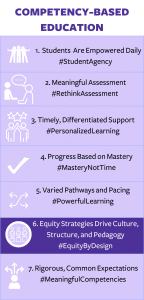
Aurora added Element 6 in the updated 2019 definition to intentionally elevate equity as a key to designing and creating a competency-based learning system. Equity drives the other elements, too. For example, Elements 1-5 work together to provide equitable support for every learner in reaching their learning goals.
Element 6 covers a lot of ground. It draws our attention to the larger areas of policy and systems transformation we need, such as funding, educator training systems, workforce diversity, and accountability.
Elevating equity invites each of us to join in aligning our actions and our systems with an asset-based approach to diversity, belonging, and inclusion. By integrating an equity lens, our culture, structures, and pedagogy build and help us refine our vision and actions for the future.
What does embedding equity in culture, pedagogy, and structures look like?
Example 1: The Young Women’s Leadership School of Astoria and the NYC Competency Collaborative
 At The Young Women’s Leadership School in Astoria (TYWLS, pronounced “twills”), ten shared outcomes drive the curriculum, instruction, and assessment of every teacher, in every subject. These shared outcomes (Argue, Be Precise, Collaborate, Communicate, Conclude, Create, Discern, Innovate, Investigate and Plan) define a broader definition of success that includes the skills needed to be successful in college, career, and beyond. Shared language drives a culture of transparency and community. Students know what they need to improve upon and there are multiple opportunities across assignments and classes to learn. Pedagogical practices, such as metacognitive reflection after an assessment, and structures, such as student-led conferences, center equity through explicitly teaching and modeling what students need to know and be able to do. The teacher-team practice of looking at student work includes a discussion of the cognitive moves students could make to deepen and grow their understanding. This illustrates a commitment to equity in intentionally teaching the mindsets and skills that too often are hidden beneath the surface of learning, and thus only accessed by some.
At The Young Women’s Leadership School in Astoria (TYWLS, pronounced “twills”), ten shared outcomes drive the curriculum, instruction, and assessment of every teacher, in every subject. These shared outcomes (Argue, Be Precise, Collaborate, Communicate, Conclude, Create, Discern, Innovate, Investigate and Plan) define a broader definition of success that includes the skills needed to be successful in college, career, and beyond. Shared language drives a culture of transparency and community. Students know what they need to improve upon and there are multiple opportunities across assignments and classes to learn. Pedagogical practices, such as metacognitive reflection after an assessment, and structures, such as student-led conferences, center equity through explicitly teaching and modeling what students need to know and be able to do. The teacher-team practice of looking at student work includes a discussion of the cognitive moves students could make to deepen and grow their understanding. This illustrates a commitment to equity in intentionally teaching the mindsets and skills that too often are hidden beneath the surface of learning, and thus only accessed by some.
 TWYLS Astoria participates in New York City’s Competency Collaborative (CC) as a Living Lab school. The CC team articulates their approach to creating more equitable learning cultures as being youth-centered, culturally responsive and sustaining, and using competency-based teaching, learning, and grading practices. Their implementation framework and key shifts offer practical moves and guidance for designing for equity. With over 75 member schools across the NYC public school system, schools learn from each other and the CC team as they design learner-centered, competency-based models that work in their contexts.
TWYLS Astoria participates in New York City’s Competency Collaborative (CC) as a Living Lab school. The CC team articulates their approach to creating more equitable learning cultures as being youth-centered, culturally responsive and sustaining, and using competency-based teaching, learning, and grading practices. Their implementation framework and key shifts offer practical moves and guidance for designing for equity. With over 75 member schools across the NYC public school system, schools learn from each other and the CC team as they design learner-centered, competency-based models that work in their contexts.
Learn more about TWYLS: CompetencyWorks blog post about TWYLS, A short video about TWLYS: How does mastery transform school for students and teachers?, Intro to CBE webinar featuring TWYLS Astoria
Learn more about the Competency Collaborative: CompetencyWorks blog post about the origins of the Competency Collaborative: Dozens of NYC Schools Support Each Other’s Reforms, Videos from Competency Collaborative schools
Example 2: Washington State’s Mastery-Based Learning Collaborative (MBLC)
 The MBLC network of 20+ founding member schools across Washington State is an initiative of the Washington State Board of Education. MBLC member schools are working toward implementing high-quality mastery-based learning (MBL) and culturally responsive-sustaining education (CRSE) practices. Educational equity is a guiding value.
The MBLC network of 20+ founding member schools across Washington State is an initiative of the Washington State Board of Education. MBLC member schools are working toward implementing high-quality mastery-based learning (MBL) and culturally responsive-sustaining education (CRSE) practices. Educational equity is a guiding value.
Learn more: The MBLC Community Site includes many implementation tools and protocols. For example, the Resources page has a CRSE section with key books and web resources, and the Event Archive has recordings of several CRSE-related webinars.
Example 3: Metropolitan Arts Academy (the Met) in Westminster, CO
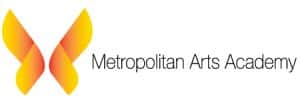 At the Met, which in 2019 transitioned from a typical competency-based elementary school within the competency-based Westminster Public Schools to a PK-8 competency-based art school, creates a culture of belonging to support student development as whole humans. The model illustrates the core values of a competency-based design for younger learners. The Met emphasizes how CBE provides equitable access to education both in the arts and in general.
At the Met, which in 2019 transitioned from a typical competency-based elementary school within the competency-based Westminster Public Schools to a PK-8 competency-based art school, creates a culture of belonging to support student development as whole humans. The model illustrates the core values of a competency-based design for younger learners. The Met emphasizes how CBE provides equitable access to education both in the arts and in general.
Learn more: CompetencyWorks blog post about the Met before it became an arts innovation school: Lessons from a Vanguard: A Look at Metz Elementary, Getting Smart podcast: Claudette Trujillo on Implementing and Sustaining Competency-Based Education, Aurora 2022 Symposium session: Rebuilding Through the Unimaginable: How the Foundation of CBE Allowed Us to Survive and Rebuild for Our Learners
What does an equitable student experience look like?

Can you see these student experiences “look fors” in the examples above?
- Students feel recognized for the assets they already possess and feel encouraged to develop their interests and talents. Simultaneously, they can build academic knowledge, skills, and competencies.
- Students sense an atmosphere of fairness. They feel that school practices are equitable and free from bias.
- Students participate authentically in school governance.
- Students intentionally learn the building blocks of lifelong learning skills and agency.
- Students exercise voice in how they learn and demonstrate their learning, which cultivates motivation and empowerment.
What policies and practices support equity?
- Learning systems address gaps in knowledge and skills to fully prepare students for more advanced studies. Learning pathways allow personalization with support to learn at a pace designed to result in students achieving mastery of college and career readiness by graduation. Academic pathways exist for students who are off-track to graduate by 18 to complete their secondary education.
- Staff members at all levels embrace cultural responsiveness in mindset and instructional practice.
- Instruction is grounded in personal relationships and incorporates Universal Design for Learning strategies. Curriculum design and review intentionally address bias and create a culture of inclusivity.
- The assessment system maintains rigor and high expectations for all students. Assessments provide ongoing opportunities to apply or transfer knowledge and skills in novel contexts to generate evidence of learning.
- Calibration processes across schools and districts reduce variability and different levels of standards for different students and communities.
- Grading practices and reporting systems produce data on student progress to monitor pacing, design supports and inform the professional learning of teachers.
Learn More
There are many blog posts, Aurora Institute Symposium sessions, webinars, toolkits, and organizations contributing to our knowledge and practice of effective personalized instruction for active learning with varied pathways and pacing. While some of these resources do not explicitly espouse a competency-based approach, the ideas and practices resonate with Aurora’s CBE definition.
- Several books could serve as a foundation for inquiry into equity. For example:
- Culturally Responsive Teaching and the Brain by Zaretta Hammond uses neuroscience to look at brain development and argue for reforms to teaching pedagogy.
- Grading for Equity by Joe Feldman examines the role of grading in equity and building student agency.
- Deeper Competency-Based Learning: Making Equitable, Student-Centered, Sustainable Shifts by Karin Hess, Rose Colby, and Daniel Joseph examines how to realize the transformative effects of adopting a competency-based model.
- Street Data: A Next-Generation Model for Equity, Pedagogy, and School Transformation, by Shane Safir and Jamila Dugan offers a reimagined approach to data analysis.
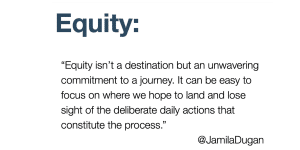
- The New York State Education Department (NYSED) worked with stakeholders to develop the Culturally Responsive-Sustaining Education Framework. The framework elevates an equity outcome (on p. 8-9), originally defined by Gloria Ladson-Billings’ early work on culturally relevant teaching, to help students become sociopolitically conscious and have a critical lens to challenge inequitable systems of access, power, and privilege.
- The research project, An Investigation of Culturally Responsive Mastery-Based Education, worked with the Competency Collaborative to examine the potential of culturally responsive education (CRE) and mastery-based education (MBE) as student-centered approaches that can advance educational equity in different ways.
- How to Diversify America’s Teaching Corps by Conra Gist and Travis Bristol summarizes the thinking that led to the development of the “Handbook of Research on Teachers of Color and Indigenous Teachers,” published by the American Educational Research Association. The handbook synthesizes the challenges involved in increasing teacher ethno-racial diversity and offers important takeaways for how to overcome them. A related resource, Increasing the Racial, Ethnic and Linguistic Diversity of the Educator Workforce: A Call to Action for Leaders, summarizes efforts to diversify the educator workforce in the New England states.
- A Primer to Indigenous Education: A Case for Tribal Competency Creditin
g opens a two-part series that explores the intersection of Native education and competency-based education and the potential to formally honor Indigenous knowledge in ways that revitalize and sustain Native communities. The blog post Sustaining and Sharing Cultural Heritage at the Tatitlek Community School illustrates one example of what this looks like in a predominantly Alaskan Native community. - The CBE Design Principle 6 Rubric is a resource from the book, Unpacking the Competency-Based Classroom, in which Jonathan Vander Els and Brian Stack offer a roadmap for transforming school in pursuit of greater equity through competency-based learning.
- A small sampling of additional CompetencyWorks blog posts exploring the topic of equity include:
- Avoiding the Pitfalls of Fake-quity: A Powerful Learning Moment from the 2022 Symposium shares a district’s equity journey and includes a list of resources.
- Improving School Equity Through A Student-Led PD Activity and an Equity Summit at Casco Bay originated in the form of a letter from the principal.
- Elevating Student Experience to Build Equitable Learning Environments, Engagement, and Agency illustrates the importance of implementing research that affirms our high expectations for all students.
- Building a Powerful School Culture at Four Rivers.
- How Competency-Based Learning Supports Culturally Responsive Curriculum.
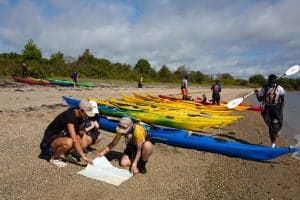
Supporting Design and Equity Principles
Element 6 of the CBE definition draws from all nine of the equity principles in Designing for Equity: Leveraging Competency-Based Education to Ensure All Students Succeed and all of the Quality Principles for Competency-Based Education. Quality and equity go hand in hand. Here I highlight the principles not explicitly addressed in the other elements of the CBE Definition.
- Nurture a Strong Culture of Learning, Inclusivity, and Empowerment (p.15)
- Invest in Adult Mindsets, Knowledge, and Skills (p.19)
- Respond and Adapt to Students Needs Using Continuous Improvement Processes (p.27)
- #2 Commit to Equity (p. 34)
- #10 Seek Intentionality and Alignment (p. 71)
- #12 Maximize Transparency (p. 81)
- #13 Invest in Educators as Learners (p. 87)
- #15 Develop Processes for Ongoing Continuous Improvement and Organizational Learning (p. 96)
Get Started
Reflecting on your own or with your team, school, district, and/or community is a great way to identify current assets to build on in bringing an equity lens to all decisions.
- What are the outcomes – from a graduate profile to a competency framework, your mission, or other sources – that drive your district or school? In what ways are the school design, learning environments, and instruction aligned with those outcomes? In what ways are they misaligned?
- Which stakeholders have been meaningfully included in your visioning process(es) and in the design of key structures, policies, and practices? Are diverse voices and perspectives regularly engaged in the decision-making in your school or district?
Once you identify strengths to build on or areas in need of new ideas, what will you do next? Consider both the short term (think: trying one new thing) and the longer term (think: strategic planning and systems change). Hopefully, the resources above give you models, tools, and ideas to use in your work.

Good luck, and if you are looking for additional resources, try browsing past posts on the CompetencyWorks Blog with its many stories of lessons learned by innovators and early adopters from across the field of K-12 competency-based education.
Read the Other Posts in the Starter Pack Series
- CBE Starter Pack 1: Students are Empowered Daily
- CBE Starter Pack 2: Meaningful Assessment
- CBE Starter Pack 3: Timely, Differentiated Support
- CBE Starter Pack 4: Progress Based on Mastery
- CBE Starter Pack 5: Learn Actively With Varied Pathways and Pacing
- CBE Starter Pack 7: Establish Rigorous, Common Expectations with Meaningful Competencies
Stay tuned for the final post!
Laurie Gagnon is the Aurora Institute’s CompetencyWorks Program Director.